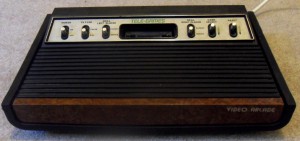Wow, I’m feeling old.
Last week, Atari celebrated its fortieth anniversary. For those not aware, Atari not only was the biggest name in arcade and home gaming in the late 1970’s and early 1980’s, it could be considered the founder of arcade gaming. Their very first video game, Pong, was the first widely successful arcade game. After that, they had a string of hits including Asteroids, Breakout, Battlezone, Centipede, and others. They were also responsible for the extremely popular Atari 2600, which became the first big home video game console.
I’m feeling old because my very first console was an Atari 2600, or rather, a Sears Video Arcade.
When I was four or five years old, I was a big fan of Space Invaders. When I turned seven (way back in 1980), my parents got me a Sears Video Arcade, which was an authorized rebrand of the Atari 2600, with a copy of Space Invaders (which, like some other Atari 2600 games, was also a Sears rebrand). They had an ulterior motive to getting me the console; I had fairly poor hand-eye coordination, so they hoped that playing the games would be a fun way for me to improve my coordination. Part of me thinks they kind of regret having done so, though, as I became obsessed with video games afterwards. My hand-eye coordination did improve, though.
Of course, history shows that Atari’s dominance ended with the video game crash of 1983. The entire industry crashed and burned; one of the biggest reasons was that everyone could make games for the Atari 2600, so everyone did. That led to a glut of shovelware games on the market causing the good games to be lost among the chaff. Atari’s own decisions were pretty poor, too, with an unfaithful port of Pac-Man and reviled adaptation of E.T. the Extra-Terrestrial damaging their brand pretty badly. The video game industry didn’t recover until the release of the Nintendo Entertainment System, whose arcade-quality graphics and lockout chip (only allowing licensed games to play) restored confidence in the industry. The company now known as Atari is Atari in name and licenses only.
To celebrate their fortieth anniversary, Atari made it where people who installed and/or used their iOS game Atari’s Greatest Hits on June 27th would have access to the entire downloadable game library (a $10 value) until such time as the app is removed or reinstalled. (I don’t believe the offer is still valid.) I went ahead and installed it that day, and gave it a try.
The app, while interesting, is something of a mixed bag. The game selection covers both arcade games and Atari 2600 games; the arcade game selection only goes up until 1984 or so, when Warner Communications sold off the arcade division of Atari, which subsequently became Atari Games. Therefore, classics such as Gauntlet and A.P.B. are not included. (The licenses for those games are held by WB Games and are included in Midway Arcade.) Also, for several of the arcade games, both the arcade and Atari 2600 versions are included. Of particular note is Tempest, whose Atari 2600 port was never released but was included anyway. Also, four of the Atari 2600 games use the Sears Tele-Games box art. While three are understandable as they were Sears exclusives, the fourth, Pong Sports, was a renamed version of Video Olympics. For obvious reasons, licensed games from other arcade manufacturers and third-party cartridges are not included.
The downside of this app is the controls. As might be expected, the games are controlled by a virtual controller on the touch screen. On a screen the size of an iPhone’s (I don’t own an iPad), it can be awkward. While a controller such as an iCADE or a JOYSTICK-IT would work nicely for the joystick-based games, several games emulate the use of a trackball, which I imagine would not work well with these controllers. It does take some getting used to, especially with the Atari 2600 games. Still, even with some practice, I still have difficulty with many of the games I used to be halfway decent on, simply due to the controls.
Still, the app is an interesting look back at the old Atari games, both arcade and console. It brought out quite a bit of nostalgia for me, and I’ve found myself trying out the odd game every so often. While Atari’s heyday is definitely long in the past, it’s good to see people recognizing their importance. More importantly, it’s fun to play the games again and seeing how many of them still hold up, even after a few decades.


I can’t imagine trying to play Tempest on anything other than arcade. I’ve seen many ports, but all pale in comparison.